
‘Pinocchio started it all for me, in 1940, when I was 4 years old. It happened at the Tampa Theater, one of the grand old depression-era movie palaces thankfully preserved still today, with all of its ornate and excessive decor, in Tampa, Florida. It has twinkling stars in the ceiling and clouds that float by. Plus lots of bare-breasted women with long flowing tresses seemingly everywhere I looked. One held the water fountain out for me to drink from. Others waved huge candlelabra of light and were strategically situated throughout the wondrous and mysterious, darkened stucco caverns. For a breast-fed kid of four it was most stimulating. There was no question of my willingness to suspend disbelief. And suspend it I did. I was instantly sucked into the cartoon from the first frame and I’m not sure I’ve ever completely returned.’ — Les Blank
‘Much like the bastions of freedom and vernacular art he so lovingly recorded, Les Blank’s films seem a kind of arcadia on the horizon of documentary film. Blank died earlier this month at the age of 77, leaving behind a singularly festive body of work. Especially in the many small masterpieces shot in Louisiana (Spend It All, 1971; Dry Wood, 1973; Hot Pepper, 1973; Always for Pleasure, 1978), Texas (The Blues Accordin’ to Lightnin’ Hopkins, 1968; A Well Spent Life, 1971; Chulas Fronteras, 1976), and North Carolina (Sprout Wings and Fly, 1983), the infectious joie de vivre found in Blank’s films offers the best imaginable antidote to the ossifying tendencies of so much documentary portraiture. No matter the subject, Blank’s films hazard to show it close to life.
‘Frederick Wiseman makes for an especially intriguing point of comparison to Blank: both filmmakers developed a consistent enough approach in style and subject as to make their numerous works seem kaleidoscopic pieces of a single chronicle of American life (Blank’s would be a roiling picaresque); both formed their own distribution companies; both emerged from the verité generation with a seemingly inexhaustible interest in observing the individual in his or her social context. Their films present contrasting pictures of what constitutes that common society, however, with Wiseman preoccupied with the institutional structures that are anathema to Blank’s freewheeling portraits. Tempting as it is to read their respective works as polarized expressions of 1960s consciousness—structuralist critique on the one hand, a kind of utopic pastoral strain on the other—both filmmakers transcended these familiar frameworks by dint of genuine curiosity and an unstinting work ethic.
‘Musicians were of special interest to Blank as figures bridging communalist folkways with stark individualism. His immersive shooting style and preference for filming these subjects at home or else in a familiar space (dances, country stores, the side of the road—anything to avoid an actual stage) lends the performances an unmistakable tang of authenticity. At home in long takes, Blank liberally employs the zoom lens for close-ups of hands and faces. The deeply subjective pleasure in gesture and expression is already apparent in those rapt moments of Dizzy Gillespie (1964) during which Blank moves in to the trumpeter’s horn and blurs focus with a musical crescendo. Blank’s lyricism depended in large measure on his subjects’ spontaneity, however, which made Gillespie’s celebrity a problem. By contrast, the variety of Lightnin’ Hopkins’ impromptu performances in The Blues Accordin’ to Lightnin’ Hopkins affords a layered portrait far more nuanced than the usual mythologies of the bluesman as lone wolf.
‘Digression is a path towards wisdom in Blank’s work, both in the space of the shot and the open narration style. Mance Lipscomb’s explanation in A Well Spent Life that his greyhounds can fetch him five or six dollars worth of jackrabbits every day is a nice example of the kind of tangent Blank’s films gladly accommodate: not worth mentioning except for being there, which is exactly the point. Meandering rivers and roads are consistent leitmotifs, and there is always time for a close-up of green onions and seasoned meat stirred into a pot over an open flame. Sprout Wings and Fly’s gentle portrait of North Carolina fiddler Tommy Jarrell includes a disquisition on moonshine whiskey and an extended sequence in which Jarrell’s sisters show Blank’s camera the many layers of tablecloths pasted over her mother’s picnic table. A Well Spent Life leaves Mance Lipscomb behind entirely for a climactic depiction of a river baptism. These are all scenes that might well furnish the film’s central subjects with material for song lyrics, giving the unmistakable impression of a deep accord existing between art and its environment, an insight most fully realized in melodic group portraits like Always for Pleasure, Spend It All, and Dry Wood—city symphonies set to the languid pace of Cajun country.
‘It was more than mere whimsy that led Blank to credit Porter Houston’s Bar-B-Q and “The People of Texas, 1967” along with Hopkins himself in the hand-painted opening titles for The Blues Accordin’ to Lightnin’ Hopkins. For one thing, the filmmaking credits are similarly generous (Blank often shared director credits with his editors and sound recorders). More to the point, the credits reflect something basic about the structure of the films, which, uniquely among such documentary portraits, do not discriminate between the marquee subject and more incidental walk-ons, but rather place them on the same plane of experience, the better to enter their world.
‘There’s a wonderful scene at the end of Sprout Wings and Fly in which one of Jarrell’s admirers asks him about Blank’s film crew. “They got some money from the government some way,” he reports. “I don’t know how they done it, and I ain’t asked them. It’s none of my business.” Blank clearly appreciated the irony of his drawing on government funds to film his pastoral lives (his work seems a late blooming of the WPA model in this respect). Similarly, he could offhandedly indicate the racial dynamics at work in his Southern settings without allowing it to frame the portrait (e.g., a wonderfully incongruous shot of white teenagers waterskiing past Hopkins and a friend fishing). A pastoral style invariably entails a certain degree of wishful projection, but Blank’s lyricism doesn’t dress his subjects up with manufactured dignity: rather, it works to expand upon the matter of fact. Blank’s slow lap dissolves are extraordinarily beautiful, more of a piece with 1930s documentary (or Bruce Baillie’s experimental films) than straight-laced verité. More specifically, there is the majestic purple sky stretching behind Lipscomb as he offers his shining account of love and religion; the dissolving images of a man canoeing that end Spend It All in grandeur and mystery; the slow final dissolve from Hopkins’ face tilted back in song to an exterior that racks focus from an idyllic field of flowers to barbed wire in the foreground (freedom and enclosure in the same image, just like the blues). These are but a few of examples of the beguiling ease with which Blank migrated between literal and abstract forms, simultaneously documenting and dreaming.
‘Many of Blank’s older subjects worry over the “fast living” that signals the demise of their traditions, though secondhand enthusiasts and avowed preservationists like Marc and Ann Savoy (the subjects of the 1991 Marc and Ann) would seem closer to onscreen vicars for Blank. Like him, they cherish the handmade, informal old-time ways; unlike him, they identify with a single culture. The films themselves act as a go-between, with Blank’s faithful attention to food and music reflecting an idealistic conviction in certain universals (as does his decision to distribute Kidlat Tahimik’s utterly simpatico Perfumed Nightmare). Every one of Blank’s films feels like a kind of homecoming, with the title of the Mance Lipscomb portrait illuminating the guiding question for all his work: What makes for a well spent life? Blank never tired of finding answers to that question, and the gusto with which he carried out the search is indeed an answer in itself.’ — Max Goldberg
____
Stills







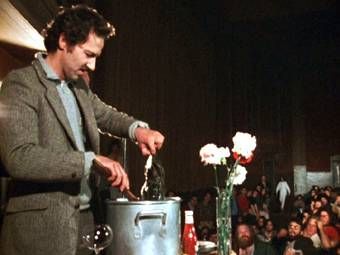
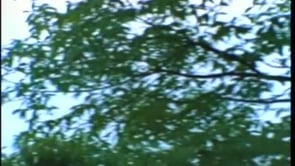




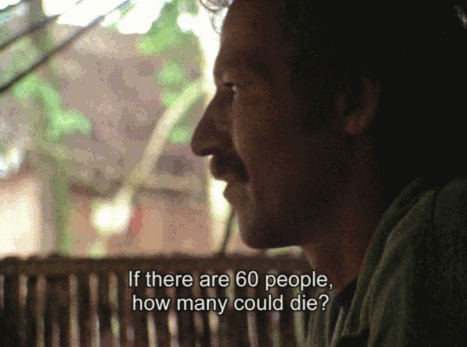
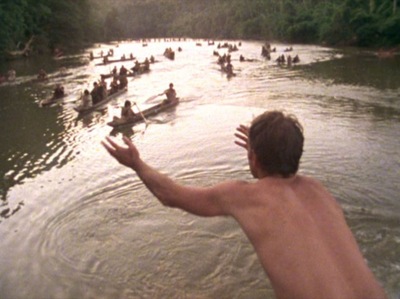


























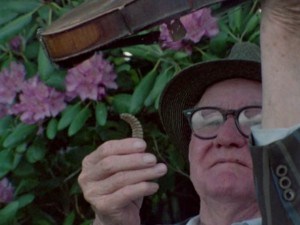

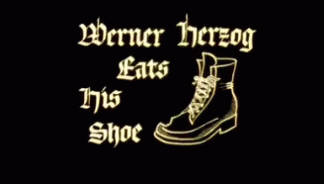


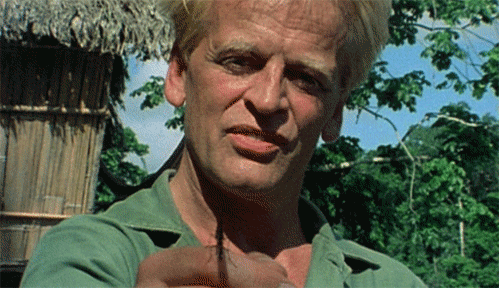







___
Further
Les Blank’s Site
Blank Slate: Remembering Les Blank
Les Blank, American Hero
Les Blank @ IMDb
Les Blank @ The Criterion Collection
The Essentials: 7 Films You Should Know From Les Blank
WHAT TODAY’S FOOD FILMS OWE TO LES BLANK
Time Well Spent: Les Blank
A Journey w. Les Blank by Comet Radio
Les Blank interviewed (2009)
Les Blank: Folklife on Film
Criterion collects the joyful, humane documentaries of Les Blank
‘The Realness’ Episode 3: A Discussion of Les Blank
Sprout Wings and Fly turns 35
The Road Les Traveled: A Les Blank Filmography
Jonah, American Epic Session and Les Blank
Filmmaker Les Blank Made Cinematic Art Out Of Interests
Damaged Goods: Les Blank
Harrod Blank’s salute to his father and film-maker Les Blank
My Favorite Documentaries: Burden of Dreams
THIS DANCE IS FOR LES BLANK
____
Extra
An American Treasure: Les Blank and his Documentary Films
_____
Interview
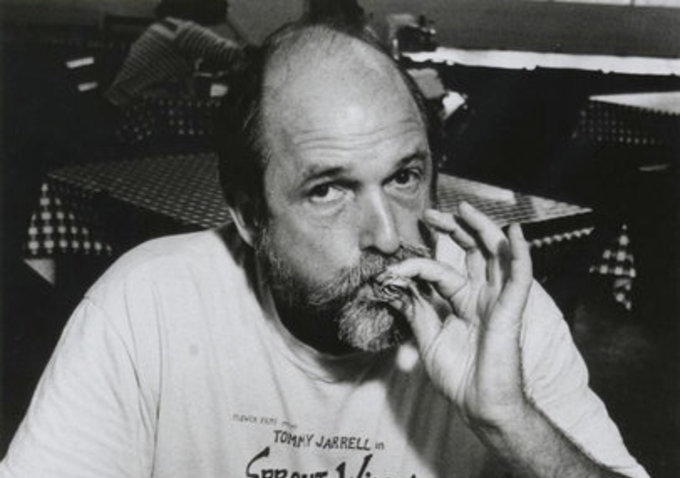
Sally Berger: One of your earliest titles is Pleasure Faire, directed by Terry Nowak, which documented the second Renaissance Fair in California in 1963/64. You were the cinematographer, using a Bell and Howell spring-wound camera. This work reminds me of another title by you, God Respects Us When We Work, but Loves Us When We Dance, which captures the first big “love-in” in Los Angeles, on Easter Sunday 1967. I believe some of the same revelers are in both films; certainly the Renaissance-style clothing inspired a lot of the “hippie” styles. Perhaps you could say something about your experience of the relationship between the Renaissance fairs and the beginning of the California counterculture?
Les Blank: There is an overlapping. People at the Pleasure Faire and the love-in were a free-spirit type of people who lived outside the box. There was something in the fairs that reflected a purity of spirit. Their sound recordings were genuine Renaissance music authentically gleaned from the period and played on the Renaissance instruments. The love-in was one of the first outdoor rock concerts filled with talented musicians such as Ray Manzarek, then the bass player from the Doors, among many others.
We didn’t have a person recording sound, so the sound track had to be recreated. I was invited to a Halloween party in an old house sponsored by the public independent television station KCET. We all dressed up in costumes inspired by Fellini films—I was dressed as a country priest. There I heard the psychedelic rock band Spontaneous Combustion and asked them to do the soundtrack. I projected the film on screen in the practice session and recording studio and they made the soundtrack to that. I tweaked the final version in the editing room.
SB: You made Dizzie Gillespie, about the jazz trumpeter, in 1965; interviewed him 20 years later for your film about Afro-Cuban percussionist Francisco Aquabella (Sworn to the Drum: A Tribute to Francisco Aquabella, 1985); and then again for Roots of Rhythm (1994), a series narrated by Harry Belafonte (not in the program). Gillespie is such a showman! How did you gain access to him for making your portrait and what was it like working with him?
LB: Dizzie Gillespie was an ebullient, uplifting person. He loved being around people. We filmed one afternoon and in the evening of the second day and at a rehearsal of the Stan Kenton Neophonic Orchestra at the Dorothy Chandler Pavilion. The performance at the Lighthouse in Hermosa Beach was shot with non-sync sound!
SB: You have worked with some of the same individuals over the years on your films, including Skip Gerson, Chris Strachwitz, Maureen Gosling, Chris Simon, and Gina Leibreicht. Please talk a bit about the role of collaborators and what working with the same people on several films brings to the quality of your productions.
LB: All these people were very social. I am shy, so working with others who are more at ease in a social situation helps. They also have good film ideas. Chris knows music and what he likes. He came to the U.S. after WWII, heard Louis Armstrong and knew that he had come to heaven. This brought him to the blues in Texas and to become an expert on Norteño, Cajun, Creole, and zydeco music. Maureen is a natural editor and worked as sound recordist, assistant camera starting in 1972, fresh out of college with a degree in anthropology. In time, she became full editor. She has a very sensitive, loving spirit and this carries through in her work.
SB: Gosling has worked with you on a number of films, including most recently the music videos of the music group and art center Los Cenzontles, and earlier on Garlic Is as Good as Ten Mothers, Burden of Dreams, Dry Wood, and Yum, Yum, Yum! A Taste of Cajun and Creole Cooking. You both traveled twice to the Amazon to shoot your documentary on Werner Herzog’s making of Fitzcarraldo, and kept fascinating journals of the adventure. You seemed really miserable at times—bored, lonely, uncomfortable with the situation and physically out of your element—and at other times, when in nature, you were full of delight. Today, when you look back at the experience, do you see it with any fresh insights?
LB: As time passes I only remember the pleasant things. It was a very rich experience. I had known Werner for a while before making the film. He knew that the film he was making was very risky and wanted it documented. He convinced the Peruvian businessman who showed him one of the abandoned boats that helped inspire the story to specifically support the documentary.
SB: Gina Leibrecht collaborated with you as a codirector on All in This Tea (2007) and the work-in-progress How to Smell a Rose (2011) (about Ricky Leacock). These recent works seem to have a more developed dramatic structure, less based on pure observation and music. What accounts for this change in style?
LB: Gina needs a dramatic arc; this is the way she works. She majored in film at the University of Oregon. She edited Frank Green’s Counting Sheep and Karina Epperlein’s Phoenix Dance, which made the short list for Best Short Subject Documentary in 2006.
SB: What kind of advice might you have for emerging documentary filmmakers today? What types of things are different from when you started out making films in the mid 1960s to an emerging filmmaker in 2011?
LB: Do it while you can do it. Just plunge in, don’t put all your energy into making preparations. Everyone is making films today—you have to find a way to distinguish yourself.
SB: Please share some of your favorite shooting experiences and some of your least favorite experiences. Your films are often about having a good time, but is this always the case for the filmmaker?
LB: One of my worst experiences was in New York City while working on an industrial film; I did industrials to support my independent filmmaking. The company made carbon paper and White-Out—these materials either absorbed light or reflected it and the shooting conditions were terrible. The film got finished somehow, but not without me being covered in black carbon.
While making Burden of Dreams I remember vividly a long boat ride at night, at the end of an exhausting, difficult day shooting a big scene with hundreds of Indians and canoes. The stars and moon were shining very bright in the clean, pure air and aromatic, night-blooming blossoms were thoroughly intoxicating—you could only experience something like this in the jungle. Michael Goodwin had come down to work as my assistant, replacing Pacho Lane in the last couple of weeks and was sitting next to Herzog. Goodwin said something like “Aren’t the stars beautiful?” and Herzog responded, “The stars are a mess.” I knew we had to capture these sentiments about the shoot that Herzog was feeling; we soon found an opportunity to do so and the interview is in Burden of Dreams.
SB: I would characterize your work as being about humanity, culture, and unique individuals, as well as the inspiration of music, dance, food, and abandon. What are the things in your life—early experiences, people, your own nature—that helped define this vision?
LB: Eating, music, theater, and the arts inspire me. Hearing the musical notes of a trombone and the steel guitar for the first time…listening to Ernest Tubb’s Midnight Jamboree at Summer camp in Tennessee… I grew up in Tampa, Florida and enjoyed meeting people who were different from me—Cubans and African Americans lived in my neighborhood. My mother made me go to Sunday school, but I liked the country honky tonks better. I would go to the Florida State Barn Dance where it was rowdy and the music lively. People opened up their tailgates and talked, drank, fought, and danced all night.
SB: What other filmmakers, artists, film, art, music, culinary arts, writing, poetry, dancing, drinking, and socializing helped you to define your own ideas in filmmaking?
LB: Ingmar Bergman made me realize I wanted to become a filmmaker. When I saw The Seventh Seal for the first time I was in a pretty low state—he showed me a world where someone was worse off then me. And he showed me that art and beauty can come from the worst misery of the human experience. I was also profoundly moved by the work of Robert Flaherty, Robert Gardner, and Slavko Vorkapich.
SB: For people who are discovering your work for the first time, which films would you suggest they go to see first?
LB: The Blues Accordin’ to Lightnin’ Hopkins, Burden of Dreams, Chulas Fronteras, Gap Toothed Women, Garlic Is as Good as Ten Mothers, Always for Pleasure, God Respects Us When We Work, but Loves Us When We Dance, In Heaven There Is No Beer?, Spend It All, Sprout Wings and Fly, A Well Spent Life, Werner Herzog Eats His Shoe, Dry Wood, Hot Pepper—I like all of my films!
_____________
16 of Les Blank’s 43 films
_____________
Dizzy Gillespie (1964)
‘This is Les Blank’s earliest music film, focusing on the renown trumpet player, Dizzy Gillespie, who along with Charlie Parker, Thelonius Monk, Sonny Rollins and others sparked the change from traditional Jazz to “Bebop” in mid 1940s America. The film includes rare images of Gillespie playing on his famous bent horn, and talking about his beginnings, as well as his theories about music.’
Excerpt
_____________
God Respects Us When We Work, But Loves Us When We Dance (1968)
‘Hippies and flower children dance and create rituals at the historic Los Angeles “Love-In” of Easter Sunday, 1967. This ’60s classic documents a once-in a lifetime phenomenon, preserving all the fashions, energy and idealism of the first “alternative lifestyles.” Psychedelic special effects!’
Excerpt
_____________
The Blues According to Lightnin’ Hopkins (1967)
‘The great Texas bluesman Lightnin’ Hopkins is captured in this emotional and revealing feature length film. Blank reveals Lightnin’s inspiration, and features a generous helping of classic blues.’
Excerpt
_____________
Spend It All (1971)
‘Blank’s rich portrayal of the lives and music of the French-speaking Cajuns of Louisiana, featuring the Balfa Brothers, Marc Savoy and Nathan Abshire.’
Excerpt
Werner Herzog on ‘Spend It All’
_______________
Hot Pepper (1973)
‘Blank’s musical portrait of Zydeco King Clifton Chenier, who combines the pulsating rhythms of Cajun dance music and black R&B; with African overtones, belting out his irresistible music in the sweaty juke joints of South Louisiana.’
Excerpt
______________
Always for Pleasure (1978)
‘An intense insider’s portrait of New Orleans’ street celebrations and unique cultural gumbo: Second-line parades, Mardi Gras, Jazz Fest. Features live music from Professor Longhair, the Wild Tchoupitoulas, the Neville Brothers and more.’
Excerpt
______________
Garlic is as Good as Ten Mothers (1980)
‘Blank’s zesty paean of praise to the greater glories of garlic is a passionate foray into the history, consumption, cultivation and culinary/curative powers of the stinking rose.’
Excerpt
_______________
Werner Herzog Eats His Shoe (1980)
‘German film director Werner Herzog really does eat his shoe to fulfill a vow to fellow filmmaker Errol Morris — boldly exemplifying his belief that people must have the guts to attempt what they dream of.’
Excerpt
______________
Burden of Dreams (1982)
‘Blank’s feature-length documentary about the messianic German director Werner Herzog struggling against desperate odds in the Amazon basin to make his epic feature, Fitzcarraldo.’
Excerpt
_____________
Sprout Wings and Fly (1983)
‘Blank’s emotional tribute to Appalachian culture profiles legendary, old-time fiddler Tommy Jarrell.’
Excerpt
_______________
In Heaven There is No Beer? (1984)
‘Blank’s joyous romp through the dance, food, music, friendship, and even religion of the Polka.‘
Excerpt
_______________
Cigarette Blues (1985)
‘This is a microcosmic Les Blank film in which bluesman Sonny Rhodes simultaneously addresses three of the filmmaker’s longstanding obsessions: death, cigarette smoking, and the nature of the blues. Soundtrack features Sonny Rhodes and the Texas Twisters performing at Eli’s Mile High Club in Oakland, California.’
Excerpt
______________
Innocents Abroad (1991)
‘Innocents Abroad takes an amusing look at how Europeans and Americans stereotype each other, and also examines the validity of twentieth-century-style high speed, mass tourism. It is a glimpse into an important industry which is vital to the European economy, but which also takes a very real toll on the continent, both culturally and ecologically. The eclectic soundtrack includes Mozart, Bob Dylan, Sandy Denny, Jonathan Richman, and others.’
Excerpt
______________
Sworn to the Drum (1995)
‘Blank’s documentary tribute to Francisco Aguabella, perhaps the finest Afro-Cuban master percussionist still living.’
Excerpt
______________
All In This Tea (2007)
‘All In This Tea takes us into the world of tea by following world-renowned obsessive tea expert David Lee Hoffman to some of the most remote regions of China in search of the best handmade teas in the world.’
Excerpt
_______________
How to Smell a Rose: A Visit with Ricky Leacock in Normandy (2014)
‘This film documents Les Blank’s year 2000 visit with the legendary co-founder of Direct Cinema, Richard Leacock (1921-2011). At his farm in Normandy, France, Blank, and co-director Gina Leibrecht, recorded conversations with Leacock about his life, his work, and his other passion: cooking! In the early sixties, together with Robert Drew, D.A. Pennebaker, and the Maysles brothers, Leacock changed the way documentary films were made. Before then the standard way of making films involved heavy and cumbersome equipment—standing lights, tripods, cables, etc.—that limited the access the filmmakers had to their subjects. Leacock’s technical and aesthetic innovations were instrumental in creating a new form of documenting events on film by abandoning these impediments, giving birth to America’s version of cinéma vérité. His quest was to create, “the feeling of being there.” While cooking, and taking walks in the French countryside, Leacock shares with Blank the memorable moments of his filmmaking career, and the extraordinary people he met along the way.’
Excerpt
*
p.s. Hey. ** David Ehrenstein, Hi. I’ll go find out why that is of enormous importance, thank you. ** _Black_Acrylic, Oh, Ben, wow, that’s intense. I’m sorry for the stress and worrying. Thank goodness it was mild and discovered and treated so rapidly, and no doubt he’ll be fine and will take appropriately good care of himself from now on. but, yeah, hugs, my friend, and let us know how everything goes. ** Steve Erickson, Hi. Yikes, yesterday was a scary one for parents. Getting old is really tough, and facing the mortality of the old is as tough as anything can be. I hope your mom gets through this malady quickly and smoothly. Hang in there. Safe trip home today. ** Nik, Hi, man. Yes, that is Pinget’s largest physical novel by a long shot and probably his best known and lauded. It’s interesting on its own and even more so if you’ve read the novels that preceded it because the novel is essentially the main characters of his earlier novels being interrogated. Ah, sad about no Kringle. Well, as a consolation or something, the US doesn’t know how to do French pastries well ate all, except in cases of French shop owners, and even then. I’ve never tasted, or even heard of, a great macaron in the US, for instance. Family gossip! Huh. So he just forgot to wipe off his makeup, or he was dropping a hint, or … ? That’s kind of big. I hope you’re able to write very soon, and I suspect bordering on know you will. The writing urge is kind of mosquito-like. Well, first Zac and I need to put the long, long delayed polish on our next film script so it can be translated. That’s immediate and imperative. My plan is that, once that’s finished, to, yes, get back into my novel. That would be very interesting. I’m gonna save all celebrations until we get ARTE’s opinion on it. We might be far from finished, but, oh god, I hope not. Have a goodie. ** That’s it? Okay. Today is … what is today … right, Les Blank Day. A fine day if there ever was one. Involve yourselves in it, please. See you tomorrow.



 Now available in North America
Now available in North America 
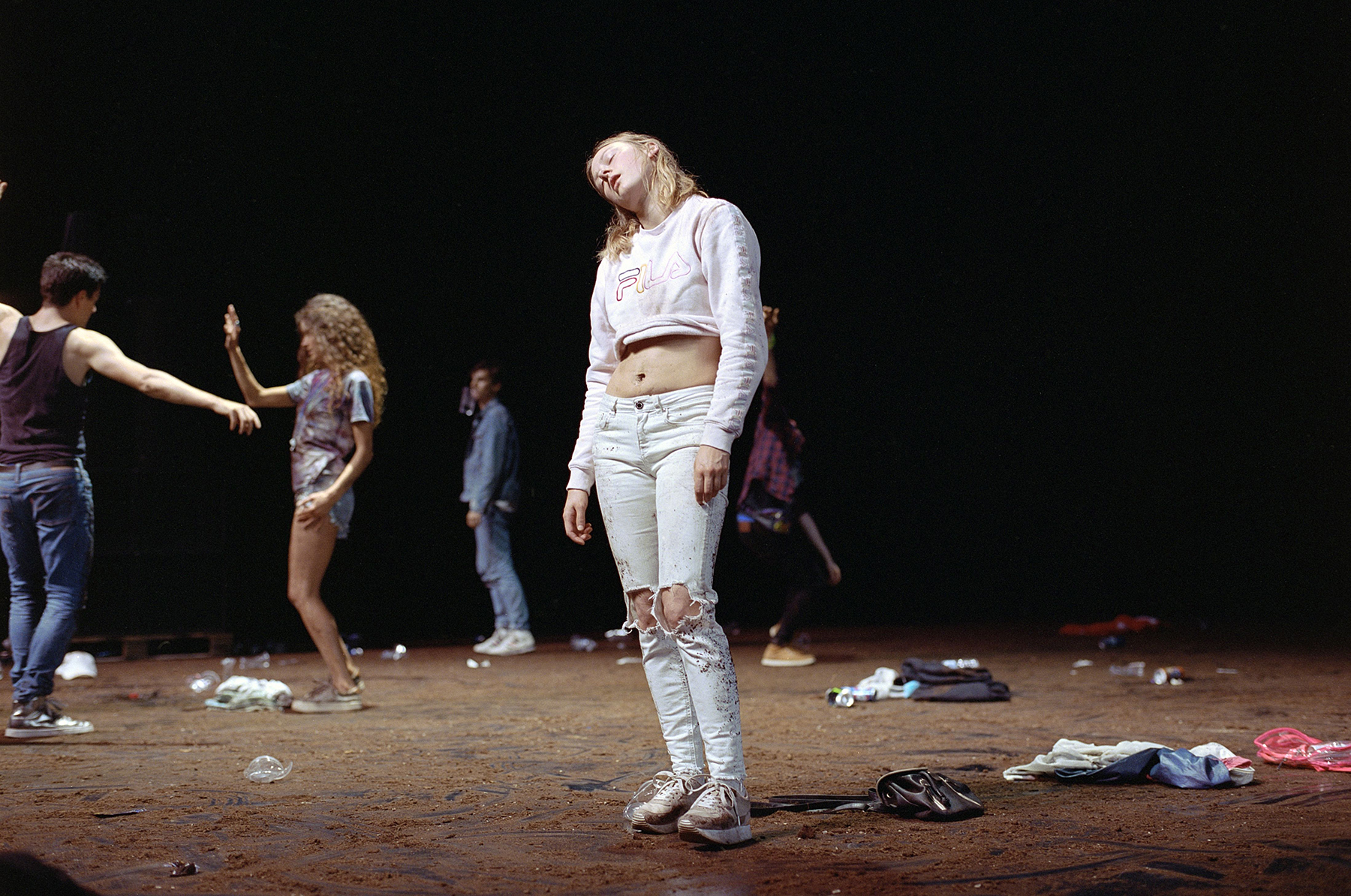 *
*
Les Blank’s films are full of joy — pure and unalloyed.
Mr. Cooper,
This might be a long-shot, but I am contacting you on behalf of one of our authors, Pam Jones, whose transcendent sci-fi-adjacent novella on fame, obsession, cult-stardom, and immortality titled IVY DAY will be released in 2019 from our press Spaceboy Books LLC. Pam is hoping that you’d be so kind as to read and write a blurb for the manuscript. It’s a truly remarkable story, twisted and mysterious, and all too human, so I would hope it might pique your interests. As requested from your website, I’m trying to contact you via your blog. I will hope to hear back from you. Thank you for your time. – Nate
Nothing says “Christmas” like a KILLER SANTA!
hey dennis, x
im back home now and back to work tmr, hurrah!
thankfully i know les blanc, so i don’t feel like a stalker
im gonna give my 2018 year a go, thank you for your’s by the way, i scribbled down some of the books, that dusty pink one ? ive read about that, forgive me dennis…
books: gary indiana / bob nickas / karl ove ( but i gave up the last book, he dumped his wife, got his teeth fixed has a new girl and stopped smoking, snowflake ) prideux’s book on strindberg /
music : bark psychosis / pusha T / velvet underground / glenn gould ( bach ) / burzum /
films : zama / western / mandy / permanent green light / first reformed / hypernormalisation /
art : i honestly hope 95% of all galleries burn to the ground and all their myopic curators are hung by their ankles from a lamp post (let the artist work it out for themselves and save 55% )
red &blue faucet’s : the moon / k pop (for a week or so, all beautifull boys but incredibly boring until (fingers crossed they jump from a window, then they’re kinda horny ) / the stumbling of morrissey / boys with shaven hair above and circulating their ear in a perfect orbit of stubble skin /adam curtis / your blog dennis, i swear / my body slowly saying bye / james kalms youtube reviews of ny art shows / off all drugs / limmy on twitch / the glimpse of a boys bare ankle above sock less sneakers and below black jeans / that tiny cancerous growth within trumps brain ” hey you, keep growing ! ” / the odd and quite sudden disappearance of any artist talking about idea’s of magick / occult / chance
ooh dennis, there’s tons more, maybe i should tap in prose, love you anyway
alex,x
I was unaware of Les Blank until today but it seems his films aren’t too hard to come by, so I went and added I Went To The Dance to my DVD rental list. His filmmaking methodology looks really intriguing and I look forward to finding out more.
I was at the hospital this afternoon to see my recuperating dad, who’s walking about with minimum aid and is right now in pretty good spirits considering. The doctors are saying they can see him making a near enough full recovery if he just follows their advice, although whether he’ll toe the line and quit the cigarettes we’ll have to wait and see haha.
is that a new Pinget post? i gotta check it out. not sure where to go with NR. interesting post today i like movies about musicians, i like music, i like movies, i think they just get in the way of my 19th century sometimes or my 80s, i dont know. tis true its gonna be a good year i cant be nasty about it it feels too hugely awesome. oh, the Tampa Theatre… Tampa is the sister city of my city, I’m there 5 days a week. You can look from St. Pete to the otherside of the bay and see Tampa. St. Pete is at the mouth of the bay, and Tampa is in the center of the old bay. Tampa is a mix of old and new, old hotels, even some Brutalism (haunted), parking lot (haunted), and new high-rise “beachy” looking apts. the white guys paved the streets with shell burial mounds. the tampa theatre has at least 3 famous ghosts, the spinning usher, who broke his neck on the slick floor doing his wonder spin and ticket trick, the projectionist whos smoke is found here and there and who finds lost objects for people, and the ghost of the organ lady, she wrote all the early soap-operas and the organ is super rare, anytime someone has almost fallen on it, they fall very lightly without breaking it. gonna check this stuff out, trying to get pumped for new years. drank a bottle of champagne and peed 500 times haha. whats up for new years? any resolutions?
I feel like this is going to come across really self-pitying but ever since I’ve realized how bad my parents are feeling, I’ve been having detailed bad dreams that feel like they last hours. (I’m not exactly calling them nightmares, because they’re fairly realistic, on subjects like returning to college and realizing that I’ve gotten in over my head.)
Criterion’s Les Blank box set is one of the best releases in their history.
Love your blog.
I have the Criterion box set. Also, Poem Is A Naked Person – both essential.
I have an all vinyl radio show. (KXCI, Tucson, 91.3 FM) I’ve played some of your spoken word on my show. This week was free jazz, Syd Barrett, psychedelic folk, funk, UK post-punk etc. Last week was 3hrs of Derek Bailey.
test